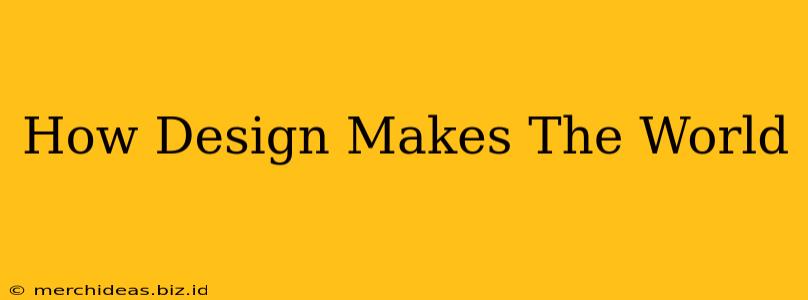Design. It's everywhere, shaping our experiences from the moment we wake up to the moment we go to sleep. But how much do we truly appreciate its impact on our lives and the world around us? This isn't just about aesthetics; it's about problem-solving, innovation, and creating a better future. Let's explore how design, in all its forms, makes the world a better place.
The Power of Design Thinking
At its core, design is about solving problems. Good design isn't just pretty; it's functional, accessible, and user-friendly. Design thinking, a human-centered approach to problem-solving, emphasizes empathy, experimentation, and iteration. This methodology allows designers to understand user needs deeply, leading to solutions that are truly effective and impactful.
Examples of Design Thinking in Action:
- Universal Design: Creating products and environments accessible to people of all abilities, breaking down barriers and fostering inclusivity. Think curb cuts, adjustable desks, and websites with screen readers.
- Sustainable Design: Prioritizing environmentally responsible practices throughout the design process, from material selection to manufacturing and disposal. This includes minimizing waste, conserving resources, and promoting circular economy models.
- Service Design: Improving the overall user experience of services, from healthcare to banking. This often involves simplifying processes, streamlining workflows, and making interactions more intuitive and efficient.
Design's Impact Across Industries
The influence of design extends far beyond the typical "design" fields. Let's look at some key examples:
1. Healthcare:
Design plays a crucial role in improving healthcare outcomes. From the design of medical devices and hospital layouts to the user interfaces of health apps, design directly impacts patient care and efficiency. Ergonomic design of medical tools reduces strain on healthcare professionals, leading to better care and reduced burnout.
2. Technology:
The rise of user-friendly technology is largely thanks to exceptional design. Intuitive interfaces, engaging apps, and accessible devices are all the result of careful consideration of user needs and behavior. Good tech design can empower users, enhance productivity, and even save lives.
3. Environmental Sustainability:
Design is critical in tackling environmental challenges. Eco-friendly products, sustainable packaging, and renewable energy infrastructure all rely on innovative design solutions to minimize environmental impact and promote sustainability. Biomimicry, a design approach that emulates nature's solutions, offers a powerful tool in creating more sustainable products and systems.
Beyond the Tangible: The Emotional Impact of Design
Design isn't just about functionality; it also profoundly impacts our emotions. A well-designed space can evoke feelings of calmness, inspiration, or excitement. A beautifully crafted object can bring joy and satisfaction. This emotional connection strengthens the power of design, making it an essential tool for building stronger communities and creating more positive experiences.
The Emotional Impact of Design Examples:
- Public Spaces: Well-designed public spaces foster a sense of community and belonging. Parks, plazas, and shared community areas can bring people together and improve well-being.
- Branding and Marketing: Effective branding uses design to create an emotional connection with consumers, building trust and loyalty.
- Product Design: The aesthetic appeal of a product can significantly impact its perceived value and desirability.
The Future of Design: A Call to Action
The future of design lies in its ability to address global challenges and build a more equitable and sustainable world. This requires designers to be more conscious of their impact, to prioritize inclusivity and sustainability, and to work collaboratively with diverse stakeholders. By embracing innovation, empathy, and a commitment to ethical practices, design can continue to shape a better future for all.
Let's continue the conversation! What are some examples of design making a positive impact in your life? Share your thoughts in the comments below.
